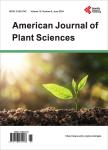Obtaining the Minimum Lethal Dose against <i>Fasciola hepatica in Vitro</i>Using Plant Extract Hexanes with Fasciolicide Activity and Toxicity Evaluation on CD1 Male Mice
Obtaining the Minimum Lethal Dose against <i>Fasciola hepatica in Vitro</i>Using Plant Extract Hexanes with Fasciolicide Activity and Toxicity Evaluation on CD1 Male Mice作者机构:Depto. De Parasitología. Facultad de Medicina Veterinaria. Y Zootecnia. UNAM. Ciudad Universitaria 04510 México D.F. México Lab. De Fitoquímica. UBIPRO. Facultad de Estudios Superiores Iztacala. UNAM. Avenida de los Barrios S/N Tlalnepantla de Baz Edo. De México.
出 版 物:《American Journal of Plant Sciences》 (美国植物学期刊(英文))
年 卷 期:2012年第3卷第7期
页 面:899-903页
学科分类:1002[医学-临床医学] 100214[医学-肿瘤学] 10[医学]
主 题:Fasciola hepatica Plant Extracts In Vitro Minimum Lethal Dose Toxicity
摘 要:Fascioliasis is a parasitic disease of worldwide distribution affecting mainly cattle and sheep. Its importance lies in the economic losses it produces in the livestock industry. Its control is carried out by using a chemical fasciolicide showing resistance problems and environmental contamination. Looking for an alternative control for this disease the present study was aimed at determining the hexane anti-Fasciola hepatica in the in vitro effect of some plant extracts and the minimum lethal dose of the mentioned extracts. All selected plants were tested in vitro at concentrations of 500, 250, 125 and 50 mg/L):Achilleamillefolium (plumajillo), Artemisiaabsinthium (wormwood), Artemisia mexicana (estafiate), Castelatortuousa (chaparroamargo), Chenopodiumgraveolens (epazote de zorrillo), Gymnospermaglutinosum (popote) Justicia spicigera (muicle), Limpia critridora (cedron), Lippiagraveolens (oregano), Menthapiperita (Mint), Populus alba (alamo) and Thymusvulgaris (thyme). Subsequently proceeded to perform a toxicity study with these fractions in CD1 male mice 10-13 weeks of age, forming groups of 3-5 animals they were administered a single oral dose being (5 mg/kg, 50 mg/kg, 500 mg/kg, 2500 mg/kg and 5000 mg/kg) and were kept under observation 20 days, later were sacrificed and a kidney and liver histology was performed, finding the safety of the extracts. To perform the toxicity study with these fractions, groups of five CD1 male-mice were formed, they were treated with oral doses of 5, 50, 500, 2500 and 5000 mg/kg, administered with a cannule. All mice were kept under observation for 20 days. Finally they were sacrificed to perform histology of the kidney and liver in search of possible side effects. Results show that none of the extracts exhibited that fasciolocide activity for mice CD1 even at the highest dose thereforefinding the safety of the extracts.



